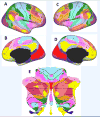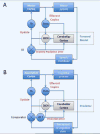The Cerebellum: Adaptive Prediction for Movement and Cognition
- PMID: 28385461
- PMCID: PMC5477675
- DOI: 10.1016/j.tics.2017.02.005
The Cerebellum: Adaptive Prediction for Movement and Cognition
Abstract
Over the past 30 years, cumulative evidence has indicated that cerebellar function extends beyond sensorimotor control. This view has emerged from studies of neuroanatomy, neuroimaging, neuropsychology, and brain stimulation, with the results implicating the cerebellum in domains as diverse as attention, language, executive function, and social cognition. Although the literature provides sophisticated models of how the cerebellum helps refine movements, it remains unclear how the core mechanisms of these models can be applied when considering a broader conceptualization of cerebellar function. In light of recent multidisciplinary findings, we examine how two key concepts that have been suggested as general computational principles of cerebellar function- prediction and error-based learning- might be relevant in the operation of cognitive cerebro-cerebellar loops.
Keywords: cerebellum; cognition; language; learning; prediction; social cognition.
Copyright © 2017 Elsevier Ltd. All rights reserved.
Figures





References
-
- Petersen SE, et al. Positron emission tomographic studies of the processing of single words. J Cogn Neurosci. 1989;1:153–170. - PubMed
-
- Fiez JA, et al. Impaired non-motor learning and error detection associated with cerebellar damage. A single case study. Brain. 1992;115(Pt 1):155–178. - PubMed
-
- Ivry RB, Fiez JA. Cerebellar contributions to cognition and imagery. In: Gazzaniga M, editor. The Cognitive Neurosciences. 2nd. MIT Press; 2000. pp. 999–1011.
-
- Ishikawa T, et al. The cerebro-cerebellum: Could it be loci of forward models? Neurosci Res. 2016;104:72–79. - PubMed
Publication types
MeSH terms
Grants and funding
LinkOut - more resources
Full Text Sources
Other Literature Sources
Medical
Miscellaneous

